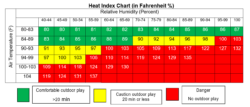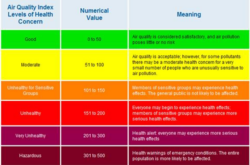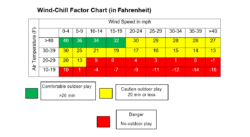On school days each campus Safety Coordinator, DCO, Assistant Headmaster and Headmaster will monitor weather conditions and use weather watcher services that provide localized electronic alerts to hazardous weather such as Zelus WBGT (Wet Bulb Globe Temperature), Weatherbug, Weather Channel, AccuWeather, Radar Scope, or other highly localized weather monitoring and reporting services that are in-line with the National Weather Service to allow real-time weather monitoring, lightning detection, tornado, severe thunderstorm, hail, ice, or other dangerous forms of weather.
Each campus will give notice of a weather delay or weather-related early release to parents/ guardians via the standard communications format that the campus uses. This will be completed as soon as possible to keep our parents completely informed of the situation.
Ice or Snowstorm: Response will be based upon district leadership direction. Communications will be distributed via district policy. All local concerns will be directed to the district.
Immediate localized hazardous weather (tornado, hail, lightning strikes): Outside activities will be halted and students returned to protective areas. This includes any outside activity or event, including student arrival, or dismissal.
Tornado Warning: During warnings related to the campus’ immediate area (tornado has been sighted) staff will not start or resume arrival or dismissal activities until the threat has been released by the National Weather Service.
Lightning During Carline: Both arrival and dismissal procedures will be halted if the lightning is within 10 miles of the campus. This can be measured using a weather application. Students and staff will return or remain inside the building, or during arrival, the student will remain with parents until the threat has moved outside of the 10-mile recommendation.
If a parent has a significant need to pick up their child during the lightning delay, the release should be made, if possible. However, the parent will assume all responsibility and must come into the building and escort their child(ren) to their vehicle. Campus will not assist with this process or getting the parent’s vehicle out of the carline.
If a campus determines that a severe electrical storm is going to occur that will disrupt campus activities during drop off or afternoon pick up, the campus may, if adequately staffed, initiate drop off or pick up early, prior to the storm. Notification must be sent to parents/guardians as soon as possible. Early release or drop off should not be more than 30 minutes before the normal time.
Lightning During Events/Athletics:
In the United States, the National Severe Storms Laboratory (NSSL) estimates that 100 fatalities and 400-500 injuries requiring medical treatment occur from lightning strikes every year. As a result, lightning is a serious situation and one not to be taken lightly.
At all outdoor events, a GH staff member will be responsible for the continuous monitoring of the area weather using WeatherBug or another localized weather monitoring application. In case of severe weather, when lightning strikes are detected at about a 20-mile radius, the campus Headmaster, Assistant Headmaster, Director of Campus Operations, Campus Safety Coordinator, or Athletic Director will coordinate the campus response in concert with the campus headmaster or designee. Notification may be sent to parents or guardians warning them of the approaching storm and the possibility of a student hold due to the storm.
When lighting strikes are detected within a 10-mile radius of the event location, all players, coaches, officials, and spectators will move to a safe shelter, staying away from tall or individual trees, lone objects (light or flag poles), metal objects, and open fields.
Once practice or play has been suspended due to lightning, practice or play will not resume until 30 minutes after the last unsafe strike (10 miles or closer).
Parent responsibilities during outside events: On-site parents should ensure that you and your student move to a place of safety. The on-site lightning shelter includes the campus buildings. Remember to not touch any metal areas while sheltering in a vehicle. While walking to the vehicle stay low as best you can and away from light poles. Do not step into water puddles. Post-up canopies or temporary pavilions commonly used for parking lot tailgating are not good shelter options as they tend to have metallic frames that may attract lightning and are not grounded. If you are advised to take shelter, do not procrastinate. Thunderstorms can move very fast and present danger from miles away. When told to take shelter, take shelter immediately. Evacuating the stands is mandatory and action will be taken to ensure that the stands are quickly and orderly evacuated.
Students’ responsibilities: Follow instructions from event staff and take immediate shelter as directed. Do not dawdle or procrastinate.
Generally, at sporting events, the home team is responsible for weather monitoring and suspension of activities (notification of game officials who actually declare a suspension in a sporting event). However, GH coaches and directors must always monitor weather conditions and are prepared to act should a hazardous situation occur and the home teams fail to act. It is recommended that GH guidelines be followed at home or away to help ensure the safety of our students.
Lighting deaths are always caused by cardiac and respiratory arrest. In the event someone is struck by lightning the GH Medical Emergency system should be activated, and CPR / ADE should be initiated immediately if necessary. A lightning victim does not carry an electrical charge on their body and is no danger to those administrating aid.
Lightning Safe Shelters:
Examples of safe shelters include campus buildings, a school bus, locker room, or other hard roof and walled structures. Bleachers or awnings are not considered safe shelters and should be avoided. There are primary and secondary safe shelters:
• A primary safe shelter is a building that is normally occupied or used by the school. (Example- any building with plumbing and or electrical wiring that acts to electrically ground the building.)
• Secondary safe shelters are vehicles with a hard metal roof. Not a convertible or golf cart. Hardtop vehicles offer a metal roof to dissipate lightning should a strike hit the vehicle. Vehicles are not the best shelter but are significantly better than being outdoors. No one in the vehicle should touch any of the vehicle’s metal, such as the doors, or roof.
Flash to Bang Method
In the event that electronic weather monitoring is not available and as a secondary monitoring method the Flash to Bang Method should be used.
1. Count the number of seconds between the lightning flash and the thunder bang. Divide the number of seconds by 5 to determine the distance the strike is from your location.
2. EXAMPLE: If 15 seconds are counted between flash to bang, you divide 15 by 5 and your lightning distance is approximately 3 miles away.
3. Play is suspended as the Flash to Bang Method reaches 50 seconds or the 10-mile range. Lightning can strike from as far away as 10 miles in the clear blue sky, so it is best to follow the 50-30 Rule.
“50-30” Rule Criteria for Suspension of Activities: By the time the “Flash to Bang” count is approaching 50 seconds; all students and staff should already be inside a safe shelter.
Criteria for Resumption of Activities: Wait at least 30 minutes after the last sound (thunder) or observation of lightning before leaving the safe shelter to resume activities.
Thirty minutes after the last strike was chosen because a typical thunderstorm can travel up to 30 miles per hour. Lightning experts believe 30 minutes allows the storm to get 12 miles from the area. This is a safe distance to minimize the probability of a lightning strike. The existence of a blue sky and the absence of rain are not protection from lightning. Lightning can, and does, strike as far as 10 miles away from the storm cell. It does not have to be raining for lightning to strike. The 30-minute rule must not be breached for this reason.
If no safe structure or location is within a reasonable distance, find a thick grove of small trees surrounded by taller trees or a dry ditch. Assume a crouched position on the ground with only the balls of the feet touching the ground, wrap your arms around your knees, and lower your head. Minimize contact with the ground, because lightning current often enters a victim through the ground rather than by a direct overhead strike. MINIMIZE YOUR BODY’S SURFACE AREA AND MINIMIZE CONTACT WITH THE GROUND! DO NOT LIE FLAT! If unable to reach a safe shelter, stay away from the tallest trees or objects (such as light poles or flag poles), metal objects (such as fences or bleachers), individual trees, standing pools of water, and open fields. Avoid being the highest object in a field. Do not take shelter under a single, tall tree.
Adult spectators and student spectators accompanied by a parent or guardian will be advised to follow shelter-in-place instructions and required to move from open grandstands, however, ultimately it is the parent or guardian’s responsibility to ensure the safety of the minor.
Great Hearts Texas Weather Guidelines
All campuses should monitor the weather in order to plan for student’s playtime, field trips and educational activities. The guidelines discussed below are based on the National Weather Service and will provide information to teachers and staff as they plan for educational and recreational activities throughout the school day.
Heat Guidelines:

- Keep in mind that temperature and humidity combined determines the possible risk of heat related injury for students.
- When in the green zone, outdoor activities allowed. Be alert for early signs of heat related illness. Water breaks and rest in shade every 20 minutes.
- When in the yellow zone, start with low level activity and increase as tolerated for 20 minutes or Outdoor activities to include rest in shade and water breaks every 15 minutes. Be alert for signs of heat related illness, especially for those at a higher risk.
- When in the red zone, no outdoor activity allowed.
- Students should drink plenty of water before, during and after
- Students should be allowed to take frequent water breaks and rest as
Ozone Guidelines:
The Air Quality Index, or AQI, is a scale used to report actual levels of ozone and other common pollutants in the air. The higher the AQI value, the greater the health concerns. Shown below are the recommended guidelines set for each ozone level by the National Environmental Protection Agency concerning outdoor activity. Each teacher, coach, band director or other employee taking children out of the building is responsible for checking current ozone levels and will be responsible for abiding by GH guidelines. See below for resources to obtain this information.
The following precautions should be observed on all campuses:


Cold Weather Guidelines:
A suggested temperature for allowing students to go outside for recess and/or physical education is 40 degrees or above. However, good judgment should be used if there is a wind chill factor.

- Keep in mind that air temperature and wind speed combined will determine the length of outdoor play during cold
- Students should be dressed properly.